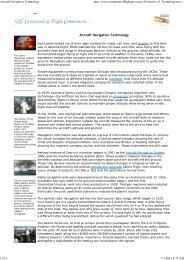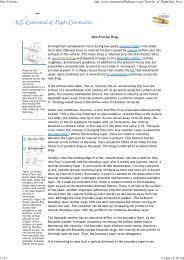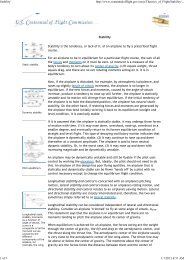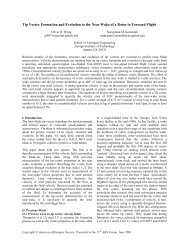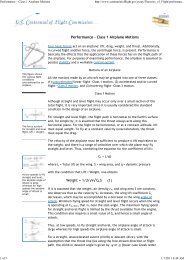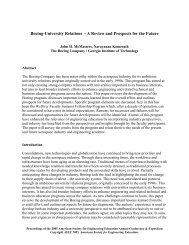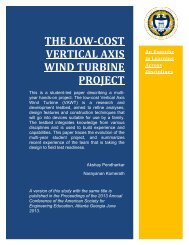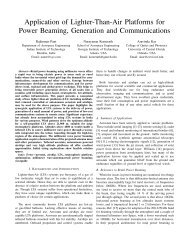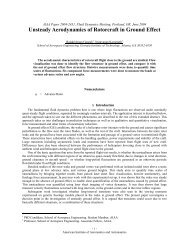Optimization of a Vertical Axis Micro Wind Turbine for Low Tip ...
Optimization of a Vertical Axis Micro Wind Turbine for Low Tip ...
Optimization of a Vertical Axis Micro Wind Turbine for Low Tip ...
You also want an ePaper? Increase the reach of your titles
YUMPU automatically turns print PDFs into web optimized ePapers that Google loves.
theory and accounting <strong>for</strong> interactions are validated against published results elsewhere. Reynolds numbereffects are clearly seen in the predictions, and their proper inclusion allows the predictions to match experimentaldata extremely well. A self-starting device using drag tubes is included in the simulation. It is seenthat the vertical axis wind turbine must operate at a tip speed ratio that is substantially greater than 1.Limiting the turbine speed <strong>for</strong> safety implies that high tip speed ratio is best achieved at low wind speedsby taking the turbine to a good operating speed using human pedaling action or an electric motor. Thiswill allow extraction <strong>of</strong> substantial amounts <strong>of</strong> power from the wind compared to what we have been able toachieve using purely self-powered machine operation. With this state <strong>of</strong> predictions we are in a position togo to detailed time-resolved simulations and thus to control algorithms <strong>for</strong> adapting to given wind patternsand optimizing power extraction and safety.AcknowledgmentsThis study was enabled by NASA Grant NNX09AF67G S01, the EXTROVERT initiative to developresources <strong>for</strong> cross-disciplinary innovation. Mr. Tony Springer is the technical monitor.References1 Komerath, N. M., “Prediction and Validation <strong>of</strong> a <strong>Micro</strong> <strong>Wind</strong> <strong>Turbine</strong> <strong>for</strong> Family Use,” Proceedings <strong>of</strong> the IMETIConference, Orlando, FL, July 2011.2 Templin, R. J., “Aerodynamic Per<strong>for</strong>mance Theory <strong>for</strong> the NRC <strong>Vertical</strong>-<strong>Axis</strong> <strong>Wind</strong> <strong>Turbine</strong>,” NASA STI/Recon TechnicalReport N , Vol. 76, 1974, pp. 16618.3 Kirke, B. K., Evaluation <strong>of</strong> Self-Starting <strong>Vertical</strong> <strong>Axis</strong> <strong>Wind</strong> <strong>Turbine</strong>s <strong>for</strong> Stand-Alone Applications, Ph.D. thesis, GriffithUniversity, 1998.4 Strickland, J. H., “The Darrieus <strong>Turbine</strong>: A Per<strong>for</strong>mance Prediction Model Using Multiple Streamtubes,” Report SAND75-0431, Sandia National Laboratories, October 1975.5 Hirsch, H. and Mandal, A. C., “A Cascade Theory <strong>for</strong> the Aerodynamic Per<strong>for</strong>mance <strong>of</strong> Darrieus <strong>Wind</strong> <strong>Turbine</strong>s,” <strong>Wind</strong>Engineering, Vol. 11, No. 3, 1987, pp. 164–175.6 Islam, M., Ting, D. S.-K., and Fartaj, A., “Aerodynamic Models <strong>for</strong> Darrieus-Type Straight-Bladed <strong>Vertical</strong> <strong>Axis</strong> <strong>Wind</strong><strong>Turbine</strong>s,” Renewable and Sustainable Energy Reviews, Vol. 12, No. 4, 2008, pp. 1087–1109.7 Sheldahl, R. E. and Klimas, P. C., “Aerodynamic Characteristics <strong>of</strong> Seven Symmetrical Airfoil Sections through 180-DegreeAngle <strong>of</strong> Attack <strong>for</strong> Use in Aerodynamic Analysis <strong>of</strong> <strong>Vertical</strong> <strong>Axis</strong> <strong>Wind</strong> <strong>Turbine</strong>s,” Tech. rep., Sandia National Laboratories,Albuquerque, NM (USA), 1981.11 <strong>of</strong> 11American Institute <strong>of</strong> Aeronautics and Astronautics



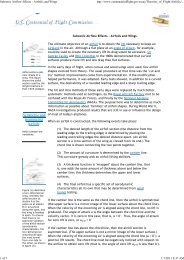

![p density of fluid, kg/m3 [Greek letter rho] V mean velocity of fluid, m ...](https://img.yumpu.com/50595898/1/184x260/p-density-of-fluid-kg-m3-greek-letter-rho-v-mean-velocity-of-fluid-m-.jpg?quality=85)
